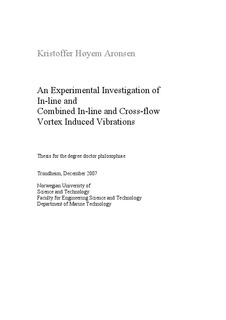| dc.contributor.author | Aronsen, Kristoffer Høyem | nb_NO |
| dc.date.accessioned | 2014-12-19T12:05:10Z | |
| dc.date.available | 2014-12-19T12:05:10Z | |
| dc.date.created | 2008-02-07 | nb_NO |
| dc.date.issued | 2007 | nb_NO |
| dc.identifier | 123442 | nb_NO |
| dc.identifier.isbn | 978-82-471-5658-2 | nb_NO |
| dc.identifier.uri | http://hdl.handle.net/11250/237623 | |
| dc.description.abstract | This thesis presents results from an experimental investigation of hydrodynamic forces on a cylinder under prescribed harmonic motions in uniform flow. The purpose of the experiments has been to find hydrodynamic coefficients for pure in-line (IL) oscillations and investigate the interaction between IL and cross-flow (CF) vortex induced vibrations (VIV). Hydrodynamic forces are hence measured in both directions.
The experiments are performed in a towing tank of 40m, using a rigid cylinder of aspect ratio 20. The cylinder is installed in a yoke structure which in turn is suspended to an overhanging tow carriage. Model oscillations are achieved by oscillating the yoke on the carriage, while the flow velocity is obtained by moving the carriage at constant speed in still water. All experiments are performed at Reynolds number 2.4•104. Three main types of experiments are carried out:
1. IL oscillations where the frequencies and amplitudes are varied to obtain a detailed map of the forces acting on a cylinder in the pure IL VIV regime.
2. Two degree-of-freedom motions resembling the oscillation patterns observed in a flexible beam experiment.
3. Two degree-of-freedom motion tests where the shape and direction of the orbital paths are systematically varied.
From the detailed knowledge of the excitation forces in the pure IL VIV regime, obtained in the first set of experiments, a novel approach for determining the effect of structural damping is introduced. This approach makes it possible to distinguish between the effect of structural damping and the effect of mass ratio on the response of a body subjected to VIV. A response model for predicting IL VIV is presented based on this method. The results also reveal that IL oscillations will give rise to CF forces that contribute to an earlier start-up of CF VIV, compared to conditions where the IL motion is restrained.
The results of the second set of experiments indicate that hydrodynamic coefficients from forced oscillation experiments and the assumption that strip theory is valid, can be used to predict two degree-of-freedom response of a flexible beam. In the third set of experiments it is revealed that changing the shape and direction of the orbital path significantly changes the forces acting on the cylinder. Hydrodynamic forces at multiples of the oscillation frequency, known as higher order harmonic forces, are also measured. | nb_NO |
| dc.language | eng | nb_NO |
| dc.publisher | Fakultet for ingeniørvitenskap og teknologi | nb_NO |
| dc.relation.ispartofseries | Doktoravhandlinger ved NTNU, 1503-8181; 2007:253 | nb_NO |
| dc.title | An Experimental Investigation of In-line and Combined In-line and Cross-flow Vortex Induced Vibrations | nb_NO |
| dc.type | Doctoral thesis | nb_NO |
| dc.contributor.department | Norges teknisk-naturvitenskapelige universitet, Fakultet for ingeniørvitenskap og teknologi, Institutt for marin teknikk | nb_NO |
| dc.description.degree | PhD i marin teknikk | nb_NO |
| dc.description.degree | PhD in Marine Technology | en_GB |
